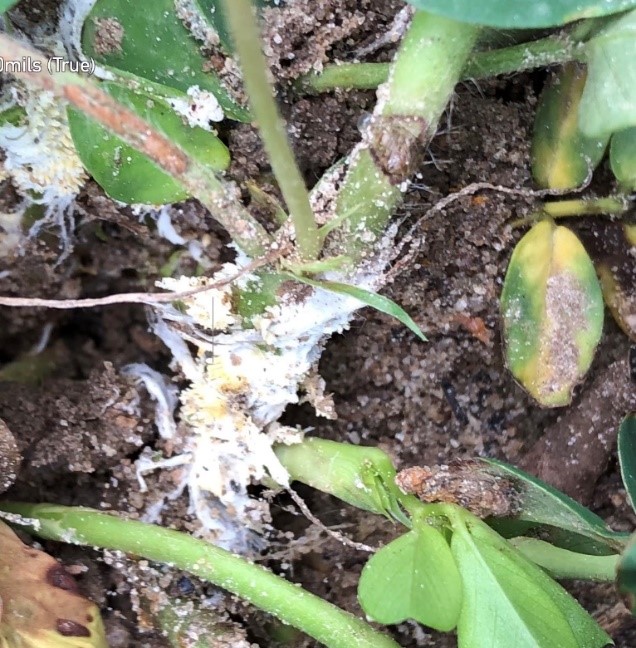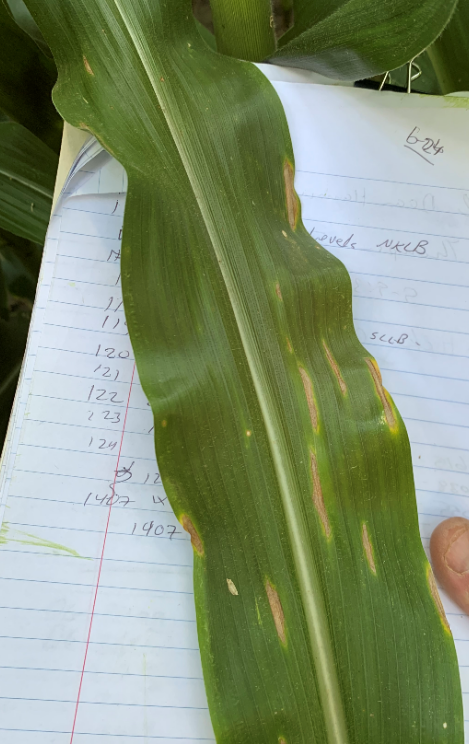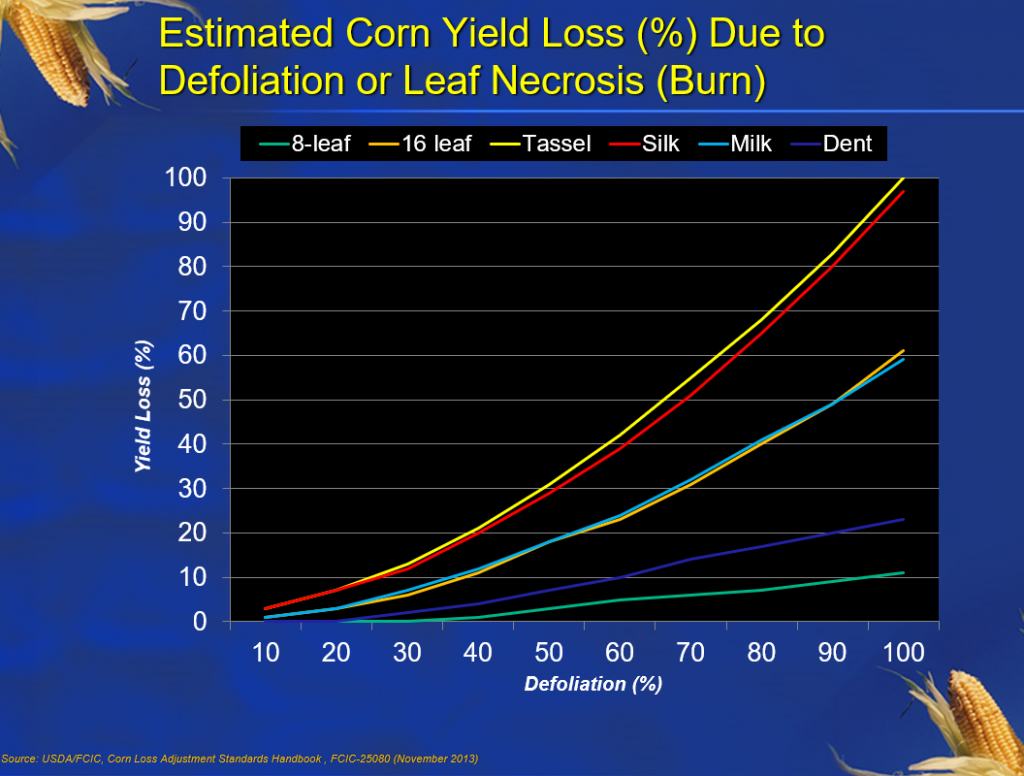Cotton: The cotton crop in the area ranges from just emerging to first bloom. Aphid populations seem to be building in some areas in the county. Aphids will typically build moderate to high numbers and eventually crash due to a naturally occurring fungus, Neozygites fresenii. This fungal epizootic typically occurs in late June or early July depending on location. According to Dr. Phillip Roberts, UGA Cotton Entomologist, the naturally occurring fungus has not been reported. For the latest update from Dr. Phillip Roberts, sign up and listen to the Pest Patrol Hotline – here is the link to the recording: https://bit.ly/2peBH6H.

Plant bugs have been variable in the area. Apply insecticide when plants are retaining less than 80% of pinhead squares and numerous plant bugs are observed. Sweep nets and drop cloths may also be used to monitor plant bugs. Sweep nets (15” in diameter) are an effective tool for monitoring adult plant bug populations. Drop cloths are more effective for monitoring immatures.
Thresholds:
First 2 weeks of squaring:
Sweep Net: 8 plant bugs/100 sweeps Drop Cloth: 1 plant bug/6 row feet
Third week of squaring through bloom:
Sweep Net:15 plant bugs/100 sweeps Drop Cloth: 3 plant bugs/6 row feet
What about Boron on cotton?: Boron (B) is an essential micronutrient that is important to flowering, pollination, and fruiting of the cotton plant. The standard UGA recommendation of 0.5 lb B/A, applied in two 0.25 lb/A foliar applications between first square and first bloom, fulfills the base requirement for B. Single applications of 0.5 lb B/A can be used but include a greater risk of foliar burn. Foliar applications above the base recommendation of 0.5 lb B/A and up to 2 lb B/A (applied in increments of no greater than 0.5 lb B/A per application) may help move nitrogen and carbohydrates from leaves into developing fruit.
Peanuts: The topic in peanut production this past week was tobacco budworm. According to Dr. Mark Abney, UGA Peanut Entomologist, Georgia peanut growers need to scout their fields this week for tobacco budworm. Infestations of this pest have been on the rise in peanut over the last fourteen days, and it does not take a lot of budworm caterpillars to cause significant defoliation when the crop is less than 50 days after emergence. We do not need to panic, and we do not need to automatically add an insecticide to our herbicide or fungicide applications. We need to scout EVERY field and determine if budworms are present and if the population is large enough to warrant treatment. There has been a lot of field to field variability in pressure, and most of the reports of injury have come from the south-central and southwest portions of the state.
Knowing when to treat caterpillars in young peanuts can be tricky. The standard 4 to 8 caterpillars per row foot is not really applicable this early in the season as that many insects per foot will likely result in complete defoliation. Research has shown that defoliation in the first 40 days after emergence has very little impact on peanut yield. While that is reassuring, I would not gamble on an early season tobacco budworm infestation. There are no “cheap” options for controlling tobacco budworm in peanuts. Growers need to know that pyrethroids will not kill this pest. Consult the University of Georgia Pest management Handbook or your local University of Georgia County Extension Agent for management options.
Tank-Mixing Cobra or Ultra Blazer with Cadre in Peanuts (Prostko)
Over the last few days, I have had a few questions about tank-mixing Cobra or Ultra Blazer with Cadre + Dual Magnum + 2,4-DB. Most are concerned about potential crop injury but this tank-mix has not been overly caustic in my research (Figures 1 and 2). But, keep in mind that crop injury with tank-mixes can vary greatly depending upon many factors including time of application, GPA, air temperature, leaf wetness, and humidity. Thus, I can provide no guarantees when 4-6 products are dumped in 1 spray tank.
Peanut growers who suspect (or are not sure) that they have ALS-resistant Palmer amaranth and/or other weeds that Cadre is less effective on (i.e. tropic croton) would greatly benefit from this tank-mix. In this scenario, Dual Magnum could be replaced by Outlook, Warrant, or Zidua (grower preference not mine). Also, I would probably avoid Anthem Flex in this particular situation because of the Aim (carfentrazone) in the Anthem Flex. When using Warrant or Zidua, a NIS should be included (0.25% v/v or 1 qt/100 gals).


Dr. Prostko has also made more comments about Anthem Flex and herbicide/fungicide tankmixes below.
Lots of folks interested in using Anthem Flex (pyroxasulfone + carfentrazone) on their peanut crop. Anthem Flex is a very good herbicide but it will cause more peanut injury than the other WSSA Group 15’s. Growers need not forget the other WSSA Group 15’s that work equally as well in the UGA recommended peanut weed control programs including Dual Magnum (s-metolachlor), Outlook (dimethenamid-P), Warrant (acetochlor), and Zidua (pyroxasulfone).

Preliminary herbicide/fungicide/peanut response tank-mix research with Provysol looks promising. I have observed similar results positive results with Cobra and Ultra Blazer.


Peanut Disease Management: The current weather pattern is great for disease development in peanuts. It can be tricky if you are starting a spray program between 45 and 50 days after planting. Bob’s top choices includes Priaxor or Lucento. Second place would be Provysol + chlorothalonil, Alto + chlorothalonil, Domark + chlorothalonil, Mazinga, and even Aproach Prima. I’d also add 7.2 teb with them for good measure.
Below is a picture of “False white mold” courtesy of Danny Bennett. According to Dr. Bob Kemerait, this looks very much like true “white mold”. But with a little age it takes on a yellow, toothed appearance. False white mold does NOT injure the peanut plant.

Corn: The area corn crop ranges from blister to early dent. The rain this week has been great from an irrigation standpoint but is also good for disease development. The BIG question now is “what corn do I spray with fungicides”?
1. Corn growers with a pre-tassel crop or one already denting? Don’t spray.
2. Corn growers Macon and north- watch and wait.
3. Corn growers with a scout in the field and no southern corn rust- you can wait, but you might need to pull that fungicide trigger all of a sudden.
4. Sprayed within the past 2 weeks? Don’t spray today, but given the threat, you might need to spray again…
5. Sprayed 3 weeks ago? I’m glad you did; now check corn growth stage before you spray again.
Southern Corn Leaf Blight
Below is a picture of Southern Corn leaf blight that I seen yesterday in a corn plot. Dr. Kemerait suggests that Southern corn leaf blight is a bigger problem for us on later planted corn; for less-resistant varieties some may apply a fungicide prior to tassel.

Late Season Defoliation on Corn. Below is information from Dr. Eric Prostko on corn defoliation at several different timings and its affect on yield. Defoliation timings include 8 and 16 leaf, tassel, silk and milk stage of development.

I have been getting a question or two about bermudagrass stem maggots. Below are a few tips to manage this pest.

Sunbelt Expo Field Day July 22nd
This half-day event, which will utilize the drive-through format deployed in 2020, is packed full of ag technology, and the latest equipment and techniques for successful farming in the southeast! Details will be announced soon at www.sunbeltexpo.com.
If you have any questions please contact your local county Extension agent.
Jeremy M. Kichler
County Extension Coordinator
Colquitt County
